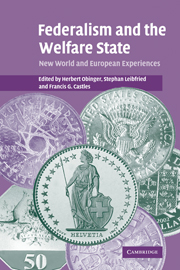24 results
The dog that didn't bark: economic development and the postwar welfare state
-
- Journal:
- European Review / Volume 8 / Issue 3 / July 2000
- Published online by Cambridge University Press:
- 13 July 2009, pp. 313-332
-
- Article
- Export citation
What Welfare States Do: A Disaggregated Expenditure Approach1
-
- Journal:
- Journal of Social Policy / Volume 38 / Issue 1 / January 2009
- Published online by Cambridge University Press:
- 01 January 2009, pp. 45-62
- Print publication:
- January 2009
-
- Article
- Export citation
The Transformation in Gender Inequality in Tertiary Education
-
- Journal:
- Journal of Public Policy / Volume 9 / Issue 4 / October 1989
- Published online by Cambridge University Press:
- 28 November 2008, pp. 493-507
-
- Article
- Export citation
Modem Welfare States: A Comparative View of Trends and Prospects, Robert R. Friedmann, Neil Gilbert and Moshe Sherer, eds. Brighton: Wheatsheaf Books, 1987.
-
- Journal:
- Journal of Public Policy / Volume 7 / Issue 2 / April 1987
- Published online by Cambridge University Press:
- 28 November 2008, pp. 210-211
-
- Article
- Export citation
Part 2 - European experiences
-
- Book:
- Federalism and the Welfare State
- Published online:
- 22 September 2009
- Print publication:
- 02 June 2005, pp 179-180
-
- Chapter
- Export citation
Note on illustrations
-
- Book:
- Federalism and the Welfare State
- Published online:
- 22 September 2009
- Print publication:
- 02 June 2005, pp xiv-xvi
-
- Chapter
- Export citation

Federalism and the Welfare State
- New World and European Experiences
-
- Published online:
- 22 September 2009
- Print publication:
- 02 June 2005
Contents
-
- Book:
- Federalism and the Welfare State
- Published online:
- 22 September 2009
- Print publication:
- 02 June 2005, pp v-vii
-
- Chapter
- Export citation
Part 1 - New World experiences
-
- Book:
- Federalism and the Welfare State
- Published online:
- 22 September 2009
- Print publication:
- 02 June 2005, pp 49-50
-
- Chapter
- Export citation
Frontmatter
-
- Book:
- Federalism and the Welfare State
- Published online:
- 22 September 2009
- Print publication:
- 02 June 2005, pp i-iv
-
- Chapter
- Export citation
Preface
-
- Book:
- Federalism and the Welfare State
- Published online:
- 22 September 2009
- Print publication:
- 02 June 2005, pp xii-xiii
-
- Chapter
- Export citation
8 - ‘Old’ and ‘new politics’ in federal welfare states
-
-
- Book:
- Federalism and the Welfare State
- Published online:
- 22 September 2009
- Print publication:
- 02 June 2005, pp 307-355
-
- Chapter
- Export citation
Index
-
- Book:
- Federalism and the Welfare State
- Published online:
- 22 September 2009
- Print publication:
- 02 June 2005, pp 356-363
-
- Chapter
- Export citation
List of tables
-
- Book:
- Federalism and the Welfare State
- Published online:
- 22 September 2009
- Print publication:
- 02 June 2005, pp ix-x
-
- Chapter
- Export citation
List of figures
-
- Book:
- Federalism and the Welfare State
- Published online:
- 22 September 2009
- Print publication:
- 02 June 2005, pp viii-viii
-
- Chapter
- Export citation
2 - Australia: federal constraints and institutional innovations
-
-
- Book:
- Federalism and the Welfare State
- Published online:
- 22 September 2009
- Print publication:
- 02 June 2005, pp 51-88
-
- Chapter
- Export citation
Part 3 - Conclusion
-
- Book:
- Federalism and the Welfare State
- Published online:
- 22 September 2009
- Print publication:
- 02 June 2005, pp 305-306
-
- Chapter
- Export citation
1 - Introduction: federalism and the welfare state
-
-
- Book:
- Federalism and the Welfare State
- Published online:
- 22 September 2009
- Print publication:
- 02 June 2005, pp 1-48
-
- Chapter
- Export citation
List of contributors
-
- Book:
- Federalism and the Welfare State
- Published online:
- 22 September 2009
- Print publication:
- 02 June 2005, pp xi-xi
-
- Chapter
- Export citation
Terra Incognito Australis: A Search for New Directions in Comparative Public Policy Analysis*
-
- Journal:
- Government and Opposition / Volume 20 / Issue 3 / 01 July 1985
- Published online by Cambridge University Press:
- 28 March 2014, pp. 370-385
- Print publication:
- 01 July 1985
-
- Article
- Export citation



